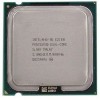Intel E2180 Design Guide - Page 59
Table, 3. Acoustic Results for ATX Reference Heatsink D60188-001, 4. Acoustic Results for ATX
 |
UPC - 683728169121
View all Intel E2180 manuals
Add to My Manuals
Save this manual to your list of manuals |
Page 59 highlights
ATX Thermal/Mechanical Design Information 6.2.2 Acoustics To optimize acoustic emission by the fan heatsink assembly, the reference design implements a variable speed fan. A variable speed fan allows higher thermal performance at higher fan inlet temperatures (TA) and lower thermal performance with improved acoustics at lower fan inlet temperatures. The required fan speed necessary to meet thermal specifications can be controlled by the fan inlet temperature and should comply with requirements listed in the following table. Table 6-3. Acoustic Results for ATX Reference Heatsink (D60188-001) Fan Speed RPM Thermistor Set Point 2900 High TA = 40 °C 1800 Low TA = 30 °C 1000 Low TA = 28 °C Acoustic Thermal Requirements, Ψca 4.5 BA 3.5 BA 0.31 °C/W (Core™2 Duo 4MB at Tc-max of 60.1 °C) 0.33 °C/W (Core™2 Duo 2MB at Tc-max of 61.4 °C) 0.33 °C/W (E2000 series at Tc-max of 61.4 °C ) 0.46 °C/W (Core™2 Duo 4MB at Tc-max of 60.1 °C) 0.48 °C/W (Core™2 Duo 2MB at Tc-max of 61.4 °C) 0.48 °C/W (E2000 series at Tc-max of 61.4 °C) Notes Thermal Design Power, Fan speed limited by the fan hub thermistor Minimum fan speed Table 6-4. Acoustic Results for ATX Reference Heatsink (E18764-001) Fan Speed RPM Thermistor Set Point Acoustic Thermal Requirements, Ψca Notes 3900 High TA = 40 °C 2000 Low TA = 30 °C 5.0 BA 3.5 BA • 0.49 °C/W (Intel Core™2 Duo processor, 4 MB / 2 MB at Tc-max of 72.0 °C) • 0.51 °C/W (Intel Core™2 Duo processor, 2 MB at Tc-max of 73.3 °C) • 0.51 °C/W (E2000 series at Tc-max of 73.3 °C ) • 0.51 °C/W (E1000 Series of Tc-max of 73.3 °C ) • 0.65 °C/W (Intel Core™2 Duo processor, 4 MB / 2 MB at Tc-max of 72.0 °C) • 0.67 °C/W (Intel Core™2 Duo processor, 2 MB at Tc-max of 73.3 °C) • 0.67 °C/W (E2000 series at Tc-max of 73.3 °C) • 0.67 °C/W (E1000 Series of Tc-max of 73.3 °C) Thermal Design Power, Fan speed limited by the fan hub thermistor NOTES: 1. Acoustic performance is defined in terms of measured sound power (LwA) as defined in ISO 9296 standard, and measured according to ISO 7779. While the fan hub thermistor helps optimize acoustics at high processor workloads by adapting the maximum fan speed to support the processor thermal profile, additional acoustic improvements can be achieved at lower processor workload by using the Thermal and Mechanical Design Guidelines 59















